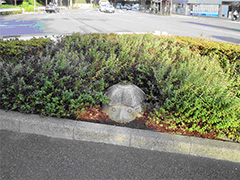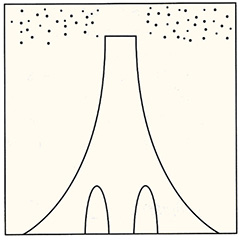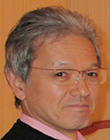Top>Research>Kappa Hill and Hearsay Rule
 Index
Index
Kappa Hill and Hearsay Rule
Ryo Ogiso
Dean, Chuo Law School, Chuo University
Area of Specialization: Criminal Law
Kappa Hill

The photograph on the right shows the monument of a kappa (a mythical monster in Japanese folklore) standing next to the pedestrian walk of Kappazaka-shita intersection.※ Kappazaka, or Kappa Hill, is located at the entrance of the Ichigaya Campus where the Chuo Law School resides. A plaque erected at the top of Kappa Hill bears the following explanation: “Long ago, there was a pond called Lotus Pond that was located near the intersection. People who saw otters living in the pond created the legend that kappas live in the pond. This was the origin of the name of Kappa Hill.” At some point afterwards, the Chinese characters used for the name of the area changed for some reason. During torrential rains which struck the area several years ago, I saw Yasukuni Road near this intersection was completely flooded. Upon learning of the origin of the name for this area, it suddenly all made sense to me.
Hearsay rule
I’m teaching criminal procedure law, a field which deals with criminal investigations and criminal trial. This field contains the “hearsay rule,” which originates from British and American law. Broadly stated, this rule declares that testimony by witnesses for whom credibility cannot be examined through cross-examination in front of judges and jurors is not admitted as evidence in court. For example, assume that Person A is suspected of purchasing illegal drugs from Person B, and is therefore arrested and prosecuted for possession of illegal drugs. The prosecutor summons Person B, who is suspected of having sold illegal drugs to Person A, to the trial in order to prove that Person A possess illegal drugs. Person B is to testify that “I sold illegal drugs to Person A.” In response, if the defense council for Person A is asserting innocence, the defense lawyer will question Person B regarding when, where, and the amount of the transaction. The defense lawyer will then dispute the credibility of Person B’s testimony by showing that Person A was in a different place at the time stated by Person B, or that Person B and Person A have never met. The court determines facts by directly observing this exchange of questions and answers. This exchange is known as cross-examination of witness, and the right of the defendant to examine witnesses is guaranteed by Article 37(2) of the Japanese constitution.
Furthermore, let’s assume that Person A is famous, and that Person B, in an attempt to show off, bragged to his drinking buddy Person C that “I sold illegal drugs to Person A, who is one of my best customers.” Even if Person C is summoned to court and questioned regarding whether or not Person A purchased illegal drugs from Person B, Person C never actually witnessed such a transaction. Person C is only able to testify that “Person B said that he sold illegal drugs to Person A.” Therefore, no progress can be made regardless of how much Person C is questioned regarding the facts of drug transactions between Person A and Person B. The portion of Person C’s testimony in which Person B is purported in having said that “I sold illegal drugs to Person A” is hearsay testimony. Hearsay rule prohibits to prove the transactions between Person A and Person B based on this kind of testimony made by Person C. This is because there is no meaning in questioning Person C as a witness regarding A-B transactions.
Cognitive activity

Why is the cross-examination of witness so important?
Within daily life, we see and hear a variety of things. For example in spring, plum trees bloom, cherry trees bloom, and people drink raucously beneath the cherry blossoms. We believe this is a true phenomena. However, are the flowers which we see really plum blossoms and cherry blossoms? “I think, therefore I am” is Descartes outstanding insight on cognition. In actuality, what we think we see and perceive is actually not the phenomenon itself; rather, it is an interpretation of the phenomenon as perceived through the cognitive code of the viewer. Let’s examine the example shown in the picture on the right.※※
What does the picture look like to you? I immediately imagined a mountain, with the black dots representing clouds. However, I didn’t have any explanation for the semi-oval circles which appear to be rabbit ears at the bottom. When I showed this picture in class, one of my students saw a human face (the semi-circles were nostrils). Then how about another possible interpretation, “looking down from the top of a ski jump runway.” The trapezoid is the ski jump runway from the perspective of the jumper, the rabbit ears are the tips of the skis, and the black dots are spectators. I’m sure that now you can also see a ski jump runway when looking at the picture again. These different interpretations of the same picture illustrate the cognitive process of what we think we saw. Even when looking at the same picture, the way in which we perceive that picture depends on the code for deciphering pictures which is held by each person.
In this way, what we think we saw differs for each person at the level of perception. One person may see the picture as Mount Fuji, while another person may see it as a ski jump runway. Information perceived by people is brought to a courtroom through the process of perception, memorization and memory reconstruction. However, there are a variety of elements which influence people’s perception. Some examples include the age, experience, and expectations, etc. of the person who witnessed the phenomenon, the brightness of the scene and the length of time, and the brutality of the phenomenon which was witnessed. Furthermore, the Ebbinghaus forgetting curve is well known in regards to the decline of memories we may have experienced. Experiments have also proven that the contents of testimony will change when unfair incentives are exerted between the time of perception and memory reconstruction. The cross-examination of witness is intended to scrutinize the credibility of testimony by uncovering errors which have entered the process of perception, memory and memory reconstruction, as well as testimony which intentionally differs from memory.
Why did otters become kappa?
I suppose now you understand why this article is entitled “Kappa Hill and Hearsay Rule.” People who possessed the code that living creatures in Lotus Pond were kappa perceived otters to be kappa, and testified that “I saw a kappa.” The perception and memory of people are surprisingly unreliable.
However, people familiar with the appearance and shape of kappa and otters may be skeptical. While otters belong to the weasel family that include sea otters and are charming animals, traditionally kappa have been depicted as rather grotesque creatures (although the monument in the photograph shown above is rather cute). Why would otters be perceived as kappa?※※※
Although otters native to Japan are now believed to be extinct, there are many species of otters living throughout the world. When searching for a picture which would resolve the doubts expressed above, I found a most unexpected photograph of an otter. I shall refrain from using the photograph due to copyright issues and to the shocking nature of the photograph, it may indicate that there was nothing absurd about people who associated otters with kappa.
Laws are made based on historical, social, and scientific background and basis. The Law School is the perfect place for conveying the breadth of such factors, and this is an important element of law study.
※ Photographed by the author
※※ Reprinted from the original image published on page 175 of Guidelines for Witness Testimony and Identification Procedures (Gendai Jinbun Publishing, 2005) by the Committee for Creating Witness Guidelines at the Japanese Society for Law and Psychology.
※※※ There is another explanation for the origin of kappa which I find to be more likely. However, I will omit that explanation from this article.
- Ryo Ogiso
Dean, Chuo Law School, Chuo University
Area of Specialization: Criminal Law - Ryo Ogiso is a Professor and Dean of the Chuo Law School and a member of the Board of Regents for Chuo University. He was born in Nagano Prefecture. Ogiso graduated from the Faculty of Law, Chuo University in 1984. He completed the Doctoral Program at the Chuo University Graduate School of Law in 1991. Prior to assuming his current position, he served as Full-Time Instructor at the Komazawa University Faculty of Law, and as Assistant Professor at the Chuo Law School, Chuo University. He is a member of the Subcommittee for National Bar Examination, a Special Member of the Legislative Council of the Ministry of Justice (Subcommittee on Punishment for Sex Crimes, etc.) and a member of Directors of the Criminal Law Society of Japan. His research focuses on comparative criminal law systems in England, America, France and Japan. His main written works include Learning Criminal Procedure (Hogakushoin, 2015) and more.
- Research Activities as a Member of Research Fellowship for Young Scientists (DC1), Japan Society for the Promotion of Science (JSPS) Shuma Tsurumi
- Important Factors for Innovation in Payment Services Nobuhiko Sugiura
- Beyond the Concepts of Fellow Citizens and Foreigners— To Achieve SDGs Goal 10 “Reduce Inequality Within and Among Countries” Rika Lee
- Diary of Struggles in Cambodia Fumie Fukuoka
- How Can We Measure Learning Ability?
—Analysis of a Competency Self-Assessment Questionnaire— Yu Saito / Yoko Neha - The Making of the Movie Kirakira Megane









